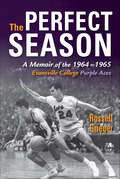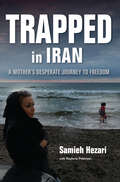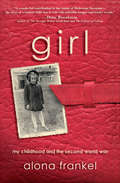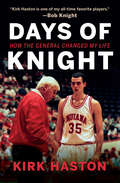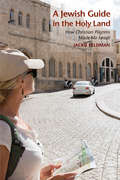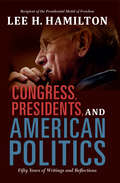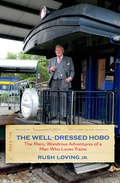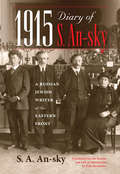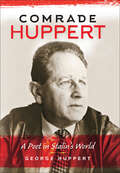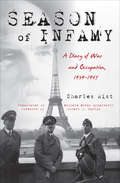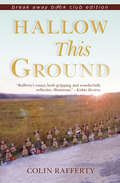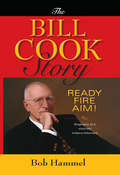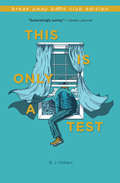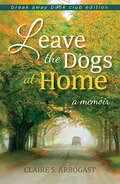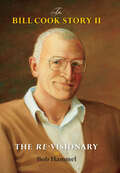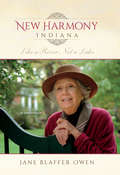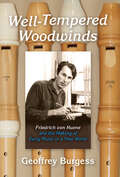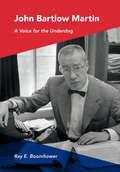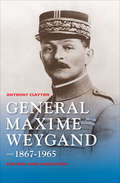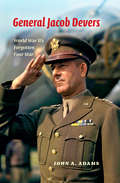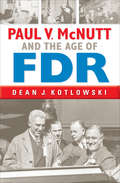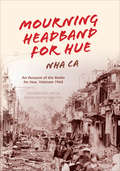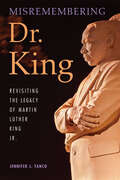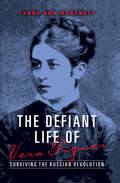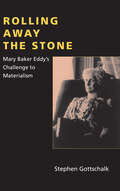- Table View
- List View
The Perfect Season: A Memoir of the 1964–1965 Evansville College Purple Aces
by Russell GriegerIn 1964, the Evansville College Purple Aces raced undefeated through the Indiana Collegiate Conference, posting a perfect 24–0 regular-season record and winning the College Division NCAA championship. The skeleton of this season exists in newspaper archives and in books that capture the on-court action, but the flesh and blood has never been written—until now. This is the story of Russell Grieger, a starting guard, and his observations, feelings, reactions, and struggles of that season. It provides a game-by-game look into the team, showcasing Grieger's teammates, Coach Arad McCutchan, and Evansville's love for the Aces. The Perfect Season is an insider's inspiring story of a team whose motto—"If you're going to go, go big time or don't go at all"—inspired them to achieve their dream.
Trapped in Iran: A Mother's Desperate Journey to Freedom
by Kaylene Petersen Samieh HezariAn Iranian woman’s memoir of returning to Iran with her daughter, only to face challenges leaving with custody of her child.In 2009, Samieh Hezari made a terrible mistake. She flew from her adopted home of Ireland to her birthplace in Iran so her fourteen-month-old daughter, Rojha, could be introduced to the child’s father. When the violent and unstable father refused to allow his daughter to leave and demanded that Samieh renew their relationship, a two-week holiday became a desperate five-year battle to get her daughter out of Iran. If Samieh could not do so before Rojha turned seven, the father could take sole custody—forever. The father’s harassment and threats intensified, eventually resulting in an allegation of adultery that was punishable by stoning, but Samieh—a single mother trapped in a country she saw as restricting the freedom and future of her daughter—never gave up, gaining inspiration from other Iranian women facing similar situations. As both the trial for adultery and her daughter’s seventh birthday loomed the Irish government was unable to help, leaving Samieh to attempt multiple illegal escapes in an unforgettable, epic journey to freedom. Trapped in Iran is the harrowing and emotionally gripping story of how a mother defied a man and a country to win freedom for her daughter.
Girl: My Childhood and the Second World War
by Alona Frankel&“An impressionistic memoir of a Polish Jewish girl&’s survival hiding as a Gentile in Nazi-occupied Poland . . . truly moving and bravely rendered.&” —Kirkus Reviews, starred review Alona Frankel was just two years old when Germany invaded Poland. After a Polish carpenter agreed to hide her parents but not her, Alona&’s parents desperately handed her over to a greedy woman who agreed to hide her only as long as they continued to send money. Isolated from her parents and living among pigs, horses, mice, and lice, Alona taught herself to read and drew on scraps of paper. The woman would send these drawings to Alona&’s parents as proof that Alona was still alive. In time, the money ran out and Alona was tossed into her parents&’ hiding place, at this point barely recognizing them. After Poland&’s liberation, Alona&’s mother was admitted to a terminal hospital and Alona handed over to a wealthy, arrogant family of Jewish survivors who eventually cast her off to an orphanage. Despite these daily horrors and dangers surrounding her, Alona&’s imagination could not be restrained. Faithful to the perspective of the heroine herself, Frankel, now a world-renowned children&’s author and illustrator, reveals a little girl full of life in a terrible, evil world. &“A wonderful contribution to the canon of Holocaust literature—the story of a hidden child that is told with indelible images and tender words.&” —Thane Rosenbaum, author of How Sweet It Is!
Days of Knight: How the General Changed My Life (Encounters: Explorations in Folklore and Ethnomusicology)
by Kirk Haston&“A personal glimpse into how the legendary Indiana basketball coach taught and mentored his team.&”—Jared Jeffries, former Indiana Hoosier and New York Knick What happens when a 6' 9" kid from Lobelville, Tennessee is recruited by legendary basketball coach Bob Knight? Kirk Haston&’s life was changed forever with just a two-minute phone call. With previously unknown Knight stories, anecdotes, and choice quotes, Haston gives fans an inside look at the notoriously private man and his no-nonsense coaching style. Which past Hoosier basketball greats returned to talk to and practice with current teams? How did Knight mentally challenge his players in practices? How did the players feel when Knight was fired? In this touching and humorous book, Haston shares these answers and more, including his own Hoosier highs—shooting a famous three-point winning shot against number one ranked Michigan State—and lows—losing his mom in a heartbreaking tornado accident. Days of Knight is a book every die-hard IU basketball fan will treasure.
A Jewish Guide in the Holy Land
by Jackie FeldmanFor many Evangelical Christians, a trip to the Holy Land is an integral part of practicing their faith. Arriving in groups, most of these pilgrims are guided by Jewish Israeli tour guides. For more than three decades, Jackie Feldman--born into an Orthodox Jewish family in New York, now an Israeli citizen, scholar, and licensed guide--has been leading tours, interpreting Biblical landscapes, and fielding questions about religion and current politics. In this book, he draws on pilgrimage and tourism studies, his own experiences, and interviews with other guides, Palestinian drivers and travel agents, and Christian pastors to examine the complex interactions through which guides and tourists "co-produce" the Bible Land. He uncovers the implicit politics of travel brochures and religious souvenirs. Feldman asks what it means when Jewish-Israeli guides get caught up in their own performances or participate in Christian rituals, and reflects on how his interactions with Christian tourists have changed his understanding of himself and his views of religion.
Congress, Presidents, and American Politics: Fifty Years of Writings and Reflections
by Lee H. HamiltonWhen Lee H. Hamilton joined Congress in 1965 as a US Representative from southern Indiana, he began writing commentaries for his constituents describing his experiences, impressions, and developing views of what was right and wrong in American politics. He continued to write regularly throughout his 34 years in office and up to the present. Lively and full of his distinctive insights, Hamilton's essays provide vivid accounts of national milestones over the past fifty years: from the protests of the Sixties, the Vietnam War, and the Great Society reforms, through the Watergate and Iran-Contra affairs, to the post-9/11 years as the vice chairman of the 9/11 commission. Hamilton offers frank and sometimes surprising reflections on Congress, the presidency, and presidential character from Lyndon Johnson to Barack Obama. He argues that there are valuable lessons to be learned from past years, when Congress worked better than it does now. Offering history, politics, and personal reflections all at once, this book will appeal to everyone interested in understanding America of the 20th and 21st centuries.
The Well-Dressed Hobo: The Many Wondrous Adventures of a Man Who Loves Trains (Railroads Past and Present)
by Rush Loving Jr.A &“sweeping and grand epic on the renaissance of American railroading&” from the Fortune journalist and author of The Men Who Loved Trains (The Baltimore Sun). After decades of covering the railroad industry for Fortune magazine, journalist Rush Loving Jr. offers his unique insider&’s view into the many dramas, triumphs, failures, and adventures of the great American railroads. Loving has shared meals and journeys with everyone from the industry&’s greatest leaders to conductors, brakemen and even a few hobos. Now, in this fascinating combination of history and memoir, he recalls the many colorful people he&’s met on the rails. Loving shares stories he collected in locomotive cabs, business cars, executive suites and even the White House. They paint a compelling, intimate portrait of the railroad industry and its leaders, both inept and visionary. Above all, Loving tells stories of the dedicated men and women who truly love trains and know the industry from the rails up.
1915 Diary of S. An-sky: A Russian Jewish Writer at the Eastern Front (Encounters: Explorations in Folklore and Ethnomusicology)
by S. A. An-SkyThe WWI diary of the Russian Jewish activist and author of The Dybbuk presents &“an unforgettable portrait of life, culture, and destruction&” (Eugene Avrutin, author of Jews and the Imperial State). By the outbreak of World War I, S. An-sky was a well-known writer, a longtime revolutionary, and an ethnographer who pioneered the collection of Jewish folklore in Russia's Pale of Settlement. In 1915, An-sky took on the assignment of providing aid and relief to Jewish civilians trapped under Russian military occupation in Galicia. As he made his way through the shtetls there, close to the Austrian frontlines, he kept a diary of his encounters and impressions. In his diary, An-sky describes conversations with wounded soldiers in hospitals, fellow Russian and Jewish aid workers, and Jewish civilians living on the Eastern Front. He recorded the brutality and violence against the civilian population, the complexities of interethnic relations, the practices and limitations of philanthropy and medical care, Russification policies, and antisemitism. In the late 1910s, An-sky used his diaries as raw material for a lengthy memoir in Yiddish, published under the title The Destruction of Galicia. Although most of An-sky&’s original diaries were lost, two fragments are preserved in the Russian State Archive of Literature and Art. Translated and annotated here by Polly Zavadivker, these fragments convey An-sky's vivid perceptions and enlightening insights.
Comrade Huppert: A Poet in Stalin's World
by George HuppertThis biography of a twentieth-century poet “deftly trac[es] Hugo Huppert’s improbable path from Jewish Galicia to Soviet Moscow to postwar Vienna” (Choice).After discovering the autobiography of the Austrian communist and writer Hugo Huppert (1902–1982), historian George Huppert became absorbed in the life and work of this man, a Jew, perhaps a relative, who was born a few months after George’s father and grew up just miles away. Hugo seemed to embody a distinctly central European experience of his time, of people trapped between Hitler and Stalin.Using the unvarnished account found in Hugo’s notebooks, George Huppert takes the reader on a tour of the writer’s life from his provincial youth to his education and radicalization in Vienna; to Moscow, where he meets Mayakovski and is imprisoned during Stalin’s purges; through the difficult war years and return to Vienna; to his further struggles with the communist party and his blossoming as a writer in the 1950s.Through all the twists and turns of this story, George remains a faithful presence, guiding the way and placing Hugo’s remarkable life in context. Comrade Huppert is a story of displacement and exile, the price of party loyalty, and the toll of war and terror on the mind of this emblematic figure.
Season of Infamy: A Diary of War and Occupation, 1939-1945
by Charles Rist&“A valuable account of what one significant and perceptive Frenchman experienced during the protracted disgrace of France as a vassal state of Nazi Germany.&” —Publishers Weekly In 1939, the 65-year-old French political economist Charles Rist was serving as advisor to the French government and consultant to the international banking and business world. As France anxiously awaited a German invasion, Rist traveled to America to negotiate embargo policy. Days after his return to Paris, the German offensive began and with it the infamous season of occupation. Retreating to his villa in Versailles, Rist turned his energies to the welfare of those closest to him, while in his diary he began to observe the unfolding of the war. Here the deeply learned Rist investigates the causes of the disaster and reflects on his country&’s fate, placing the behavior of the &“people&” and the &“elite&” in historical perspective. Though well-connected, Rist and his family and friends were not exempt from the perils and tragedies of war, as the diary makes clear. Season of Infamy presents a distinctive, closely-observed view of life in France under the occupation.
Hallow This Ground
by Colin RaffertyBeginning outside the boarded-up windows of Columbine High School and ending almost twelve years later on the fields of Shiloh National Military Park, Hallow This Ground revolves around monuments and memorials--physical structures that mark the intersection of time and place. In the ways they invite us to interact with them, these sites teach us to recognize our ties to the past. Colin Rafferty explores places as familiar as his hometown of Kansas City and as alien as the concentration camps of Poland in an attempt to understand not only our common histories, but also his own past, present, and future. Rafferty blends the travel essay with the lyric, the memoir with the analytic, in this meditation on the ways personal histories intersect with History, and how those intersections affect the way we understand and interact with Place.
The Bill Cook Story
by Bob HammelBill Cook epitomizes the American success story. His business ventures in medical devices, pharmaceuticals, genetics, real estate, retail management, and travel services have made him a billionaire. Yet, Cook continues to lead a modest life, involving himself in a variety of philanthropic activities that have included historic preservation and even a marching band. This riveting story is the first-ever biography of the entrepreneur who, working from the spare bedroom of his Bloomington, Indiana, apartment in 1963 with a $1,500 investment, began to construct the wire guides, needles, and catheters that would become the foundation of the global multi-billion-dollar Cook Group. Biographer Bob Hammel, with extraordinary access to Cook, his files, and his associates, has created a vivid portrait of this modern, multidimensional Horatio Alger--quirky humor, widely varied interests, and all. Informative and inspiring, this book celebrates an exceptional self-made individual.
This Is Only a Test (Break Away Book Club Edition)
by B. J. HollarsThe Truman Capote Prize-winning author &“provides an offbeat look at the fragility of human life and our resilience when faced with death&” (Kirkus). On April 27, 2011, just days after learning of their pregnancy, B. J. Hollars, his wife, and their future son endured the onslaught of an EF-4 tornado. There, while huddled in a bathtub in their Alabama home, mortality flashed before their eyes. With the last of his computer battery, Hollars began recounting the experience, and would continue to do so in the following years, writing his way out of one disaster only to find himself caught up in another. In this collection of personal essays, Hollars faces tornadoes, drownings, and nuclear catastrophes. These experiences force him to acknowledge the inexplicable while he attempts to overcome his greatest fear—the impossibility of protecting his newborn son from the world&’s cruelties. Through his and others&’ stories, Hollars creates a constellation of grief, tapping into the rarely acknowledged intersection between fatherhood and fear, sacrifice and safety, and the humbling effect of losing control of our lives.
Leave the Dogs at Home, Break Away Book Club Edition: A Memoir
by Claire S. ArbogastClaire and Jim were friends, lovers, and sometimes enemies for 27 years. In order to get health insurance, they finally married, calling their anniversary the "It Means Absolutely Nothing" day. Then Jim was diagnosed with cancer. With ever-decreasing odds of survival, punctuated by arcs of false hope, Jim's deteriorating health altered their well-established independence as they became caregiver and patient, sharing intimacy as close as their own breaths. A year and a half into their marriage, Jim died from lung/brain cancer. Sustained by good dogs and gardening through the two years of madness that followed, Claire soldiered through home repairs, career disaster, genealogy quests, and "dating for seniors" trying to build a better life on the debris of her old one. Leave the Dogs at Home maps and plays with the stages of grief. Delightfully confessional, it challenges persistent, yet outdated, societal norms about relationships, and finds relief in whimsy, pop culture, and renewed spirituality.
The Bill Cook Story II: The Re-Visionary
by Bob HammelA look into the final years of the billionaire entrepreneur and philanthropist and his work in historic preservation in Indiana.Working from the spare bedroom of his Bloomington, Indiana, apartment in 1963 with a $1,500 investment, Bill Cook began to construct the wire guides, needles, and catheters that would become the foundation of the global multi-billion-dollar Cook Group. This story has been eloquently told in Bob Hammel’s The Bill Cook Story: Ready, Fire, Aim. The sequel to this story explores Cook’s final years, when the restoration work he championed, epitomized by the spectacular West Baden Hotel, became a driving force in his life and a source of great satisfaction and pleasure. Hammel takes us behind the scenes on the important restorations of Beck’s Mill, a Methodist Church that is now Indiana Landmarks Center, and the remarkable commitment of Cook toward reviving his hometown, Canton, Illinois. At the heart of the book are the events of Bill Cook’s final days and his death in April, 2011, but this solemn chronicle soon gives way to fond recollections of Cook’s extraordinary life and legacy, and to the continuing saga of the company he founded as it looks toward a bright future.“In The Bill Cook Story II: The Re-Visionary, Bob Hammel engagingly highlights several of Cook’s major restoration efforts, and also chronicles how he remained dedicated to such work even as his health failed.” —Indiana Magazine of History
New Harmony, Indiana
by Jane Blaffer Owen Jane Dale Owen Nancy Mangum Mccaslin Anne Dale Owen John Philip Newell J. Pittman McgeheeFor nearly seven decades, Jane Blaffer Owen was the driving force behind the restoration and revitalization of the town of New Harmony, Indiana. In this delightful memoir, Blaffer Owen describes the transformational effect the town had on her life. An oil heiress from Houston, she met and married Kenneth Dale Owen, great-great-grandson of Robert Owen, founder of a communal society in New Harmony. When she visited the then dilapidated town with her husband in 1941, it was love at first sight, and the story of her life and the life of the town became intertwined. Her engaging account of her journey to renew the town provides glimpses into New Harmony's past and all of its citizens--scientists, educators, and naturalists--whose influence spread far beyond the town limits. And there are fascinating stories of the artists, architects, and theologians who became part of Blaffer Owen's life at New Harmony, where, she says, "My roots could sink deeply and spread."
Well-Tempered Woodwinds: Friedrich Von Huene And The Making Of Early Music In A New World (Publications Of The Early Music Institute Ser.)
by Geoffrey BurgessFriedrich von Huene (1928- ) is arguably the most important manufacturer of historical woodwinds in the 20th century. Since he began making recorders in 1958, von Huene has exerted a strong influence on the craft of building woodwind instruments and on the study of instrument-making, as he has helped to shape the emerging field of Early Music performance practice. Recipient of lifetime achievement awards from the American Musical Instrumental Society, the National Flute Association, and Early Music America, he has remained at the forefront of research and design of historical copies of recorders, flutes, and oboes. In a compelling narrative that combines biography, cultural history, and technical organological enquiry, Geoffrey Burgess explores von Huene's impact on the craft of historical instrument-making and the role organology has played in the emergence of the Early Music movement in the post-war era.
John Bartlow Martin
by Ray E. BoomhowerDuring the 1940s and 1950s, one name, John Bartlow Martin, dominated the pages of the "big slicks," the Saturday Evening Post, LIFE, Harper's, Look, and Collier's. A former reporter for the Indianapolis Times, Martin was one of a handful of freelance writers able to survive solely on this writing. Over a career that spanned nearly fifty years, his peers lauded him as "the best living reporter," the "ablest crime reporter in America," and "one of America's premier seekers of fact." His deep and abiding concern for the working class, perhaps a result of his upbringing, set him apart from other reporters. Martin was a key speechwriter and adviser to the presidential campaigns of many prominent Democrats from 1950 into the 1970s, including those of Adlai Stevenson, John F. Kennedy, Lyndon B. Johnson, Robert F. Kennedy, Hubert Humphrey, and George McGovern. He served as U.S. ambassador to the Dominican Republic during the Kennedy administration and earned a small measure of fame when FCC Chairman Newton Minow introduced his description of television as "a vast wasteland" into the nation's vocabulary.
General Maxime Weygand, 1867-1965: Fortune and Misfortune (Encounters: Explorations in Folklore and Ethnomusicology)
by Anthony ClaytonThis lively biography of the French military commander chronicles his legendary and controversial career through WWI, WWII, and beyond. The extraordinary life of General Maxime de Nimal Weygand offers a fascinating glimpse into the perils and politics of 20th century French military leadership. From obscure origins, Weygand rose to a distinguished career as chief of staff for Marshal Foch during World War I and continued to serve his country after the war in Poland and Syria. Alarmed by Nazi Germany&’s prodigious rearmament, Weygand locked horns with politicians who were blind to the growing military threat. In fact, he faced accusations that his desire for a strong army was anti-democratic. With German invaders again threatening Paris, Weygand argued for armistice rather than face certain military defeat. During Nazi occupation, he was no friend of the newly-installed Vichy government, and was sent to North Africa. There, he plotted the army&’s return to the Allied cause and was imprisoned. Released at wars end, he was rearrested on the orders of Charles de Gaulle and afterwards fought to restore his name. In this concise biography, Anthony Clayton traces the vertiginous changes in fortune of a soldier whose loyalty to France and to the French army was unwavering.
General Jacob Devers: World War II's Forgotten Four Star
by John A. AdamsA &“solid and informative&” biography of one of the overlooked heroes of the Second World War (Wall Street Journal). Of the leaders of the American Army in World War II, Jacob Devers is undoubtedly the &“forgotten four-star.&” Plucked from relative obscurity in the Canal Zone, Devers was one of four generals selected by General of the Army George Marshall in 1941 to assist him in preparing the Army for war. He quickly became known in Army circles for his &“can do&” attitude and remarkable ability to cut through red tape. Among other duties, he was instrumental in transforming Ft. Bragg, then a small Army post, into a major training facility. As head of the armored force, Devers contributed to the development of a faster, more heavily armored tank, equipped with a higher velocity gun that could stand up to the more powerful German tanks, and helped to turn American armor into an effective fighting force. In spring 1943, Devers replaced Dwight Eisenhower as commander of the European Theater of Operations, then was given command of the 6th Army Group that invaded the south of France and fought its way through France and Germany to the Austrian border. In the European campaign to defeat Hitler, Eisenhower had three subordinate army group commanders: British Field Marshall Bernard Montgomery, Omar S. Bradley, and Jacob Devers. The first two are well-known; here the third receives the attention he properly deserves.
Paul V. McNutt and the Age of FDR (Encounters: Explorations in Folklore and Ethnomusicology)
by Dean J. KotlowskiThis &“definitive biography of Indiana Gov. Paul V. McNutt&” shows the politician&’s &“importance on the national stage" through the Great Depression and WWII (Indianapolis Star).The 34th Governor of Indiana, head of the WWII Federal Security Agency, and ambassador to the Philippines, Paul V. McNutt was a major figure in mid-twentieth century American politics whose White House ambitions were effectively blocked by his friend and rival, Franklin Delano Roosevelt. This historical biography explores McNutt&’s life, his era, and his relationship with FDR. McNutt&’s life underscores the challenges and changes Americans faced during an age of economic depression, global conflict, and decolonialization. With extensive research and detail, biographer Dean J. Kotlowski sheds light on the expansion of executive power at the state level during the Great Depression, the theory and practice of liberalism as federal administrators understood it in the 1930s and 1940s, the mobilization of the American home front during World War II, and the internal dynamics of the Roosevelt and Truman administrations.
Mourning Headband for Hue: An Account of the Battle for Hue, Vietnam 1968
by Nha Ca&“An intimate―and disturbing―account of war at its most brutal, told from the point of view of civilians trying to survive the maelstrom.&” —Publishers Weekly Vietnam, January, 1968. As the citizens of Hue are preparing to celebrate Tet, the start of the Lunar New Year, Nha Ca arrives in the city to attend her father&’s funeral. Without warning, war erupts all around them, drastically changing or cutting short their lives. After a month of fighting, their beautiful city lies in ruins and thousands of people are dead. Mourning Headband for Hue tells the story of what happened during the fierce North Vietnamese offensive and is an unvarnished and riveting account of war as experienced by ordinary people caught up in the violence. &“A visceral reminder of war&’s intimate slaughter.&” —Kirkus Reviews &“[A] searing eyewitness account . . . It makes for an intimate―and disturbing―account of war at its most brutal told from the point of view of civilians trying to survive the maelstrom.&” —VVA Veteran
Misremembering Dr. King: Revisiting The Legacy Of Martin Luther King Jr
by Jennifer J. YancoWe all know the name. Martin Luther King, the great American Civil Rights leader. But most people today know relatively little about King, the campaigner against militarism, materialism, and racism—what he called the "giant triplets. " Jennifer J. Yanco takes steps to redress this imbalance. "My objective is to highlight the important aspects of Dr. King’s work which have all but disappeared from popular memory, so that more of us can ‘really see King. ’" After briefly telling the familiar story of King’s civil rights campaigns and accomplishments, she considers the lesser-known concerns that are an essential part of his legacy. Here we are reminded that King was an anti–Vietnam War activist who argued that resources spent on militarism and national security served few at the expense of many; that growing materialism and an ethos of greed was damaging the moral and spiritual health of the country even as it impoverished a disproportionate number of blacks; and that the way to address the harm done to blacks by centuries of racism was to do something special to help them compete on a just and equal basis.
The Defiant Life of Vera Figner: Surviving the Russian Revolution (Encounters: Explorations in Folklore and Ethnomusicology)
by Lynne Ann HartnettA &“riveting&” biography of a Russian noblewoman turned revolutionary terrorist and accomplice in the assassination of a tsar (The Soviet and Post-Soviet Review). Born in 1852 in the last years of serfdom, Vera Figner came of age as Imperial Russian society was being rocked by the massive upheaval that culminated in the Bolshevik revolution of 1917. At first a champion of populist causes and women&’s higher education, which she herself pursued as a medical student in Zurich, Figner later became a leader of the terrorist party the People&’s Will—and was an accomplice in the assassination of Tsar Alexander II in 1881. Drawing on extensive archival research and careful reading of Figner&’s copious memoirs, Lynne Ann Hartnett reveals how Figner survived the Bolshevik revolution and Stalin's Great Purges and died a lionized revolutionary legend as the Nazis bore down on Moscow in 1942.
Rolling Away the Stone: Mary Baker Eddy's Challenge to Materialism
by Stephen Gottschalk“Gottschalk distinguishes himself by placing Christian Science in the larger context of American religion . . . sheds new light on Eddy’s life and work.” —Publishers WeeklyThis richly detailed study highlights the last two decades of the life of Mary Baker Eddy, a prominent religious thinker whose character and achievement are just beginning to be understood. It is the first book-length discussion of Eddy to make full use of the resources of the Mary Baker Eddy Collection in Boston. Rolling Away the Stone focuses on her long-reaching legacy as a Christian thinker, specifically her challenge to the materialism that threatens religious belief and practice.“Gottschalk has provided readers with a masterful account of Christian Science in its heyday. This book is a first-rate read for students of American religion and provides a look into how one of the country’s more complex religious figures dealt with materialism in the late-nineteenth-century America.” —Religious Studies Review“Gottschalk does a superb job of providing historical context for the chaotic events of Eddy’s final decades.” —Choice“Gottschalk’s account is well told and enriched by fresh material now available from the Mary Baker Eddy Library for the Betterment of Humanity.” —Christian Science Monitor“The book includes a great deal of fresh research and honest scholarship . . . for the individual wanting to sink his or her teeth into a serious study of Eddy . . . you have a lot to look forward to in reading this book.” —The Christian Science Journal
